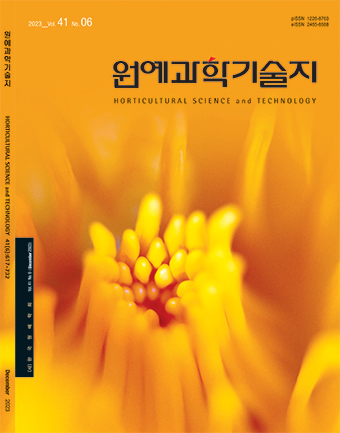- Publisher :KOREAN SOCIETY FOR HORTICULTURAL SCIENCE
- Publisher(Ko) :원예과학기술지
- Journal Title :Horticultural Science and Technology
- Journal Title(Ko) :원예과학기술지
- Volume : 32
- No :5
- Pages :730-738
- Received Date : 2014-03-10
- Revised Date : 2014-05-01
- Accepted Date : 2014-06-08
- DOI :https://doi.org/10.7235/hort.2014.14041
Abstract
References
Barbieri, G., R. Pernica, A. Maggio, S.D. Pascale, and V. Fogliano. 2008. Glucosinolates profile of Brassica rapa L. Subsp. Sylvestris L. Janch. var. esculenta Hort. Food Chem. 107:1687-1691. Bennett, R.N., J. Ludwig-Muller, G. Kiddle, W. Hilgenberg, and R.M. Wallsgrove. 1995. Developmental regulation of aldoxime formation in seedlings and mature plants of Chinese cabbage (Brassica campestris ssp. pekinensis) and oilseed rape (Brassica napus): Glucosinolate and IAA biosynthetic enzymes. Planta. 196:239-244. Bergman, F. 1970. The glucosinolate biosynthesis during the course of ontogenesis of Sinapis alba L. Z. Pflanzenphysiol. 62:362-375. Brudenell, A.J.P., H. Griffiths, J.T. Rossiter, and D.A. Baker. 1999. The phloem mobility of glucosinolates. J. Exp. Bot. 50:745-756. Bradshaw, J.E., R.K. Geaney, W.H. Macfarlane Smith, S. Gowers, D.J. Gemmell and G.R. Fenwick. 1984. The glucosinolate content of some fodder Brassicas. J. Sci. Food Agr. 35:977-981. Cartea, M.E., P. Velasco, S. Obregón, G. Padilla, and A. De Haro. 2008. Seasonal variation in glucosinolate content in Brassica oleracea crops grown in northwestern Spain. Phytochemistry 69:403-410. Charron, C.S., A.M. Saxton, and E.S. Carl. 2005. Relationship of climate and genotype to seasonal variation in the glucosinolate- myrosinase system I. Glucosinolate content in ten cultivars of Brassica oleracea grown in fall and spring seasons. J. Sci. Food Agr. 85:671-681. Chew, F.S. 1988. Biological effects of glucosinolates, p. 155-181. In: H.G. Cutler (ed.). Biologically active natural products: Potential use in agriculture. American Chemical Society, Washington, D.C. Chen, S. and E. Andreasson. 2001. Update on glucosinolate metabolism and transport. Plant Physiol. Bioch. 39:743-758. Chu, Y.F., J. Sun, X. Wu, and R.H. Liu. 2002. Antioxidants and antiproliferative activities of common vegetables. J. Agr. Food Chem. 50:6910-6916. Ciska, E., B. Martyniak-Przybyszewska, and H. Kozlowska. 2000. Content of glucosinolates in cruciferous vegetables grown at the same site for two years under different climatic conditions. J. Agr. Food Chem. 48:2862-2867. Clossais-Besnard, N. and F. Larher. 1991. Physiological role of glucosinolates in Brassica napus. Concentration and distribution pattern of glucosinolates among plant organs during a complete life cycle. J. Sci. Food Agr. 56:25-38. Cohen, J.H., A.R. Kristal, and J.L. Stanford. 2000. Fruit and vegetable intakes and prostate cancer risk. J. Natl. Cancer I. 92:61-68. De March, G., D.I. McGregor, and G. Seguin-Shwartz. 1989. Glucosinolate content of maturing pods and seeds of high and low glucosinolate summer rape. Can. J. Plant Sci. 69:929-932. Fahey, J.W., A.T. Zalcmann, and P. Talalay. 2001. The chemical diversity and distribution of glucosinolates and isothiocyanates among plants. Phytochemistry 56:5-51. Fenwick, G.R., N.M. Griffiths, and R.K. Heaney. 1983a. Bitterness in Brussels sprouts (Brassica oleracea L. var. gemmifera): The role of glucosinolates and their breakdown products. J. Sci. Food Agric. 34:73-80 Fenwick, G.R., R.K. Heaney, and W.J. Mullin. 1983b. Glucosinolates and their breakdown products in food and food plants. CRC Cr. Rev. Food Sci. 18:123-201. Fieldsend, J. and G.F.J. Milfor. 1994. Changes in glucosinolates during crop development in single- and double-low genotypes of winter oilseed rape (Brassica napus): I. Production and distribution in vegetative tissues and developing pods during development and potential role in the recycling of sulphur within the crop. Ann. Appl. Biol. 124:531-542. Grubb, C.D. and S. Abel. 2006. Glucosinolates metabolism and its control. Trends. Plant. Sci. 11:89-100. Halkier, B.A. and J. Gershenzon. 2006. Biology and biochemistry of glucosinolates. Annu. Rev. Plant Biol. 57:303-333. Jeffery, E.H., A.F. Brown, A.C. Kurilich, A.S. Keek, N. Matusheski, B.P. Klein, and J.A. Juvik. 2003. Variation in content of bioactive components in broccoli. J. Food Comp. Anal. 16:323-330. Kushad, M.M., A.F. Brown, A.C. Kurilich, J.A. Juvik, B.P. Klein, M.A. Wallig, and E.H. Jeffery. 1999. Variation of glucosinolates in vegetable crops of Brassica oleracea. J. Agr. Food Chem. 47:1541-1548. Lein, K.A. 1972. Genetical and physiological studies on the formation of glucosinolates in rape seeds: Localisation of the main site of glucosinolate biosynthesis by grafting experiments. Z Pflanzenphysiol 67:333-342. Mattaus, B. and H. Luftmann. 2000. Glucosinolates in members of the family Brassicaceae: Separation and identification by LC/ESI-MS-MS. J. Agr. Food Chem. 48:2234-2239. McGregor, D.I. 1998. Glucosinolate content of developing rapeseed (Brassica napus L “Midas”) seedlings. Can. J. Plant Sci. 68:367-380. Mithen, R.F., M. Dekker, R. Verkerk, S. Rabot, and T. Johnson lan. 2000. The nutritional significance, biosynthesis and bioavailability of glucosinolates in human foods (review). J. Sci. Food Agr. 80:967-984. Pereira, F.M.V., E. Rosa, J.W. Fahey, K.K. Stephenson, R. Carvalho, and A. Aires. 2002. Influence of temperature and ontogeny on the levels of glucosinolates in broccoli (Brassica oleracea Var. italica) sprouts and their effect on the induction of mammalian phase 2 enzymes. J. Agr. Food Chem. 50: 6239-6244. Podsedek, A. 2007. Natural antioxidants and antioxidant capacity of Brassica vegetables: A review. LWT- Food Sci. Technol. 40:1-11. Porter, A.J.R., A.M. Morton, G. Kiddle, K.J. Doughty, and R.M. Wallsgrove. 1991. Variation in the glucosinolate content of oilseed rape (Brassica napus L.), I. Effects of leaf age and position. Ann. Appl. Biol. 118:461-467. Renwick, J.A.A. 2001. Variable diets and changing taste in plant insect relationships. J. Chem. Ecol. 27:1063-1076. Rosa, E.A.S. and R. Heaney. 1996. Seasonal variation in protein, mineral and glucosinolate composition of Portuguese cabbages and kale. Anim. Feed Sci. Tech. 57:111-127. Sarwar, M. and J.A. Kirkegaard. 1998. Biofumigation potential of Brassicas. II. Effect of environment and ontogeny of glucosinolate production and implications for screening. Plant Soil. 201:91-101. Vallejo, F., F.A. Tomas-Barveran, and C. Carcia-Viguera. 2002. Potential bioactive compounds in health promotion from broccoli cultivars grown in Spain. J. Sci. Food Agr. 82:1293-1297.
Information
Journal Informaiton
 Horticultural Science and Technology
Horticultural Science and Technology
Journal Informaiton
Journal Informaiton - close
 Horticultural Science and Technology
Horticultural Science and Technology
- About This Journal
- Editorial Board
- Instructions for Authors
- Publishing Policies
- Academic Journals’ Code of Ethics












